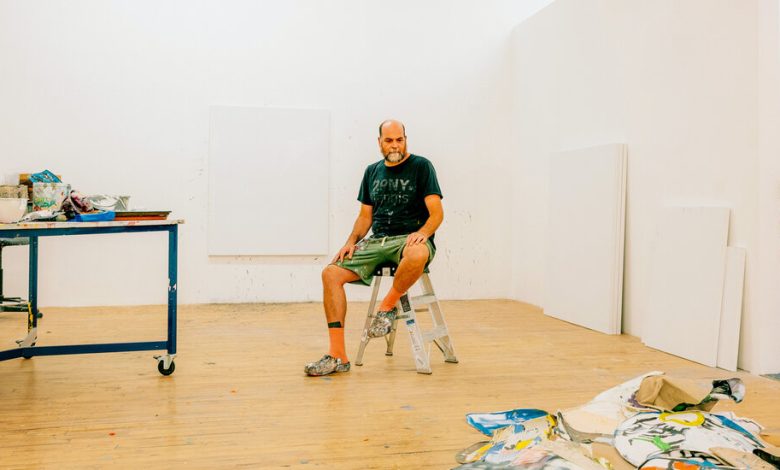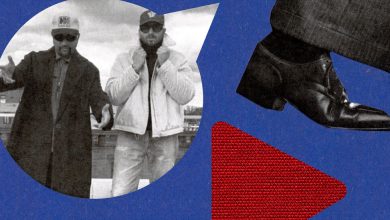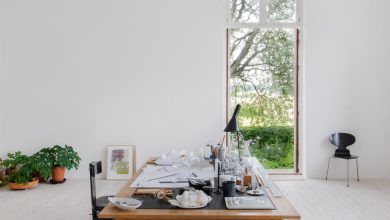Eddie Martinez Defers to the Desires of His Paints

In the artist Eddie Martinez’s dense, polychrome paintings, each mark is haunted by the gesture that made it and each color seems to demand its own verb: The thick gray drips; a bright red streak declares; a daub of blue hesitates. Even white pigment,which has frequently appeared in Martinez’s pieces since his 2018 “White Out” series, has a charged presence, boldlycounteringa base painting or washed thinly across the canvas so that the ghost of an underlying color peeks through. His teeming worksseem, on the one hand, to be urgently composed, but the carefully accrued coats of paint — sprayed, silk-screened or directly applied from pigment sticks — also point to an artist who knows how to surrender to the pace set by his materials. “I need the paint to dry to produce the layers,” Martinez tells me one overcast afternoon in his studio in Ridgewood, Queens, ahead of his solo show at London’s Timothy Taylor gallery, opening October 12. The walls are hung with pieces in varying stages of completion. He pauses in front of one and leaves a single, deliberate stroke of brown. “I have to override my impatience for the sake of letting it become the painting it needs to become,” he says.
It took time, too, for Martinez, 46, to develop his intuitive way of working. During his itinerant adolescence, which included stints in Massachusetts, Florida and California, drawing allowed him to create a stable world of his own. After high school, he spent a year at the Art Institute of Boston and then a few months at the Massachusetts College of Art and Design before he found the programs too stifling and left. Martinez started working as an art handler, first in Boston and then New York, where he also occasionally curated exhibitions after moving to the city in the early 2000s. All the while, he continued developing his artistic practice, which by then had expanded to include painting.
Although the figurative forms of his early drawings eventually loosened into abstraction, discernible objects still recur in his pieces. As Martinez explains, his outlines of bouquets, mandalas and tabletops act as “a defined space, an arena for things to happen.” The shape of a butterfly’s head, thorax and wings can be seen throughout his “Bufly” series, begun in 2021 and named after his toddler’s mispronunciation of the word. The six new, sprawling Bufly paintings that Martinez shows me, made for an exhibition at the Parrish Art Museum next year, feel as wryly inventive as the series title. For Martinez, even recognizable motifs can become opportunities to liberate meaning instead of locking it down.
Near the studio entrance, dozens of canvas scraps sit loosely heaped on the floor, fragments that the artist has excised and preserved from failed works over the years. At times, he’ll repurpose the cutouts by pasting them onto new paintings or pinning them near a work-in-progress to help when he’s in a rut. Together they form a tactile, living archive, a way of engaging with the textures of his creative history without forcing them into narrative coherence. In 2013, this instinct for collecting odds and ends led Martinez to making sculptures, at first assembling them from household objects and beachside trash. Soon, he decided to cast the pieces in bronze, often painting on top of the metallic surfaces. “It’s a compiling,” he says of his work, “a constant, diaristic thing.”
Yet drawing remains the foundation of Martinez’s practice, deeply embedded in his daily routines. When I speak to him for T’s Artist’s Questionnaire, as he settles into a homey, upholstered couch in his otherwise industrial studio, it’s fitting that he holds a piece of paper in one hand and a black Sharpie in the other.
What is your day like? How much do you sleep, and what’s your work schedule?
The day varies. It starts off with getting my son, Arthur, to school. Sometimes I play tennis, sometimes I go to the studio, but I don’t keep a supertight schedule. It’s generally a mixture of work, family and play.
What’s the first piece of art you ever made?
In high school, I made this funny painting of a hand reaching out and accessing a button that could implode the earth, and it was inside of a TV screen. It was terrible but I loved that.
What’s the worst studio you ever had?
There was this studio in Greenpoint, Brooklyn. Edgy, a lot of rats, gross. But sort of a good place to hide and work.
What’s the first work you ever sold? For how much?
I think it was a painting on paper. I say a painting on paper because at the time that was probably more practical than a canvas, cost-wise and shipping-wise. Or it might have been on a panel — some kind of heavy board. I sold that work in Sweden in 2005. I’m not sure if that was the first one, but it’s the first one I remember, and that was $600.
When you start a new piece, where do you begin?
Everything starts with drawing, and drawing doesn’t really happen in the studio; it happens in my regular life while I’m at home or traveling. Then the work comes into the studio, and oftentimes, I’ll walk around carrying my drawings, or just throw them around on the floor. I’ll take bits and pieces from different things and make new compositions. Or if there’s something I already drew that I like, I’ll pin that up and pull moments from it and start a painting.
Is that process — making those drawings in the context of your regular life and then bringing them into the studio afterward — tied to the diaristic, almost documentarylike aspect of drawing that you mentioned before?
It sounds like that, now that you say it. All my drawings start with a line drawing. I don’t use a silk screen all the time, but it’s a tool that I started employing in 2015, with the continued interest of trying to have a large painting feel like a small, intimate drawing — specifically like one made with a Sharpie on the couch. My wife, Sam [Moyer], and I got this funny stationery from our real estate broker that had our names on it, and I would make the drawings on there and then blow them up and have them silk-screened. They were called “Love Letters.” [Laughs.] Anyway, it’s a tool that I still use. Nothing is exclusive — I paint in different modes at different times.
How do you know when you’re done?
Intuition. Just how the piece feels, how it looks. I might even have a feeling that maybe it could be — or should be — a different painting, but I accept it for the painting that it is, and I really like it for the painting that it is. Sometimes, I do little rituals to help me determine if something’s done. I’ll close my eyes and walk around, spin around, just look at the thing, flip the orientations around. I also take photos every day when I leave the studio, and at night, I’ll take the paintings that I’m working on and I’ll make corrections on my phone or my iPad with the drawing app.
How many assistants do you have?
I have a studio manager, a full-time studio assistant and a part-time guy who does registrar work, imaging, stuff like that.
What music do you play when you’re making art?
I’ll listen to nothing, just silence through my headphones, or to binaural beats, brown noise, pink noise. And a lot of rap, ’90s rap, stuff like that. And then basic things like the Grateful Dead. The music has to be an intentional choice, at this point in my life and in my practice. Generally, I’ll listen to one song on repeat. What I listen to serves a purpose — it solves a problem that I think I need solved at that moment. It conjures up the feeling that I’m looking for, whether that’s through Wu-Tang Clan or Willie Nelson.
When did you first feel comfortable saying you’re a professional artist?
Probably 2008. I got a big studio, and it had been a few years since I’d had to art-handle.
Is there a meal you eat on repeat when you’re working?
I like the turkey meatballs from Fresh Direct. And I like sushi.
Are you bingeing on any shows right now?
“Reservation Dogs” is a personal favorite right now. It’s so sweet, so in that way, it’s bingeable.
What’s the weirdest object in your studio?
Probably this rubber thing that you use for exercising your elbow. [He pulls out a turquoise Theraband FlexBar.] It’s mostly for tennis elbow, but that problem is exacerbated by painting.
How often do you talk to other artists?
Well, I’m married to one! We talk daily. Does “talk” these days include text? Other than with my wife, I guess a few times a week. It’s not necessarily about what’s happening in the studio, unless you’re at one another’s studio. Just general work stuff.
What do you do when you’re procrastinating?
Same as everyone else: watch stuff on my phone.
What do you usually wear when you work?
You’re looking at it: sweatpant shorts, cut-up Crocs. They’re modified. These are not the support shoes — these are the extra-lazy shoes. These [points at a pair of Hoka sneakers] are the support shoes. They’re a limited collaboration with Engineered Garments, so I buy them on the secondary market.
What do your windows look out on?
Trees! I love those little trees. It’s amazing. It’s just like being in the suburbs.
What do you bulk buy with the most frequency?
Baby wipes. They take oil paint off your skin, really helps pull it right off.
What’s your worst habit?
There are so many. Guess if I’m being honest: binge eating. [He holds up a Diet Dr Pepper.] And probably this.
What embarrasses you?
I would say … myself. Not at all times, and not in completion, but that’s probably what I get embarrassed by — seeing myself.
Do you exercise?
I play tennis with some other artists. And I have periods of doing Pilates, which is very important for your back, especially when you’re an artist working on large-scale stuff.
What are you reading?
Don Winslow: “The Dawn Patrol” (2008) and “The Trail to Buddha’s Mirror” (1992).
What’s your favorite artwork by someone else?
I love all the little pinch bowls that Arthur’s made. Some paintings by Abstract Expressionists like Helen Frankenthaler and Grace Hartigan have blown my mind. And at Naoshima Art Island [in Japan] there’s a room that’s like a man-made cave, and there’s a Monet in it, under just natural light. It’s from very late in his career and it’s very open, with a lot of raw canvas at the bottom. It’s a very contemporary move, and it’s surprising someone was doing it that long ago.
What’s the last thing that made you cry?
Losing a very dear friend this past Friday.
When something like that happens, do you stop working or does work help you process it?
I’ve never really been in a moment like this. So far, I’m OK. I’m painting.





